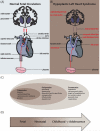Congenital cardiac anomalies and white matter injury
- PMID: 25939892
- PMCID: PMC4461528
- DOI: 10.1016/j.tins.2015.04.001
Congenital cardiac anomalies and white matter injury
Abstract
Cardiac abnormalities are the most common birth defects. Derangement of circulatory flow affects many vital organs; without proper supply of oxygenated blood, the brain is particularly vulnerable. Although surgical interventions have greatly reduced mortality rates, patients often suffer an array of neurological deficits throughout life. Neuroimaging provides a macroscopic assessment of brain injury and has shown that white matter (WM) is at risk. Oligodendrocytes and myelinated axons have been identified as major targets of WM injury, but still little is known about how congenital heart anomalies affect the brain at the cellular level. Further integration of animal model studies and clinical research will define novel therapeutic targets and new standards of care to prevent developmental delay associated with cardiac abnormalities.
Keywords: glial cells; heart; myelin; neuroimaging; oligodendrocyte.
Copyright © 2015 Elsevier Ltd. All rights reserved.
Figures


Similar articles
-
Experimental Traumatic Brain Injury Identifies Distinct Early and Late Phase Axonal Conduction Deficits of White Matter Pathophysiology, and Reveals Intervening Recovery.J Neurosci. 2018 Oct 10;38(41):8723-8736. doi: 10.1523/JNEUROSCI.0819-18.2018. Epub 2018 Aug 24. J Neurosci. 2018. PMID: 30143572 Free PMC article.
-
White matter protection in congenital heart surgery.Circulation. 2012 Feb 21;125(7):859-71. doi: 10.1161/CIRCULATIONAHA.111.048215. Epub 2012 Jan 12. Circulation. 2012. PMID: 22247493 Free PMC article.
-
Hypoxic preconditioning improves long-term functional outcomes after neonatal hypoxia-ischemic injury by restoring white matter integrity and brain development.CNS Neurosci Ther. 2019 Jun;25(6):734-747. doi: 10.1111/cns.13102. Epub 2019 Jan 28. CNS Neurosci Ther. 2019. PMID: 30689302 Free PMC article.
-
Blocked, delayed, or obstructed: What causes poor white matter development in intrauterine growth restricted infants?Prog Neurobiol. 2017 Jul;154:62-77. doi: 10.1016/j.pneurobio.2017.03.009. Epub 2017 Apr 6. Prog Neurobiol. 2017. PMID: 28392287 Review.
-
Myelin and oligodendrocyte lineage cells in white matter pathology and plasticity after traumatic brain injury.Neuropharmacology. 2016 Nov;110(Pt B):654-659. doi: 10.1016/j.neuropharm.2015.04.029. Epub 2015 May 9. Neuropharmacology. 2016. PMID: 25963414 Review.
Cited by
-
Impact of Cardiopulmonary Bypass on Neurogenesis and Cortical Maturation.Ann Neurol. 2021 Dec;90(6):913-926. doi: 10.1002/ana.26235. Epub 2021 Oct 13. Ann Neurol. 2021. PMID: 34590341 Free PMC article.
-
Antenatal and Perioperative Mechanisms of Global Neurological Injury in Congenital Heart Disease.Pediatr Cardiol. 2021 Jan;42(1):1-18. doi: 10.1007/s00246-020-02440-w. Epub 2020 Dec 29. Pediatr Cardiol. 2021. PMID: 33373013 Free PMC article. Review.
-
A Collaborative Learning Assessment of Developmental Care Practices for Infants in the Cardiac Intensive Care Unit.J Pediatr. 2020 May;220:93-100. doi: 10.1016/j.jpeds.2020.01.043. Epub 2020 Mar 5. J Pediatr. 2020. PMID: 32147219 Free PMC article.
-
Visual-spatial processing style is associated with psychopathology in adolescents with critical congenital heart disease.Clin Neuropsychol. 2019 May;33(4):760-778. doi: 10.1080/13854046.2018.1503333. Epub 2018 Dec 26. Clin Neuropsychol. 2019. PMID: 30585527 Free PMC article.
-
Neurodevelopmental Abnormalities and Congenital Heart Disease: Insights Into Altered Brain Maturation.Circ Res. 2017 Mar 17;120(6):960-977. doi: 10.1161/CIRCRESAHA.116.309048. Circ Res. 2017. PMID: 28302742 Free PMC article. Review.
References
-
- Marelli AJ, et al. Congenital heart disease in the general population: changing prevalence and age distribution. Circulation. 2007;115:163–172. - PubMed
-
- Khairy P, et al. Changing mortality in congenital heart disease. J Am Coll Cardiol. 2010;56:1149–1157. - PubMed
-
- Tabbutt S, et al. Neurodevelopmental outcomes after congenital heart surgery and strategies for improvement. Curr Opin Cardiol. 2012;27:82–91. - PubMed
Publication types
MeSH terms
Grants and funding
LinkOut - more resources
Full Text Sources
Other Literature Sources
Medical

